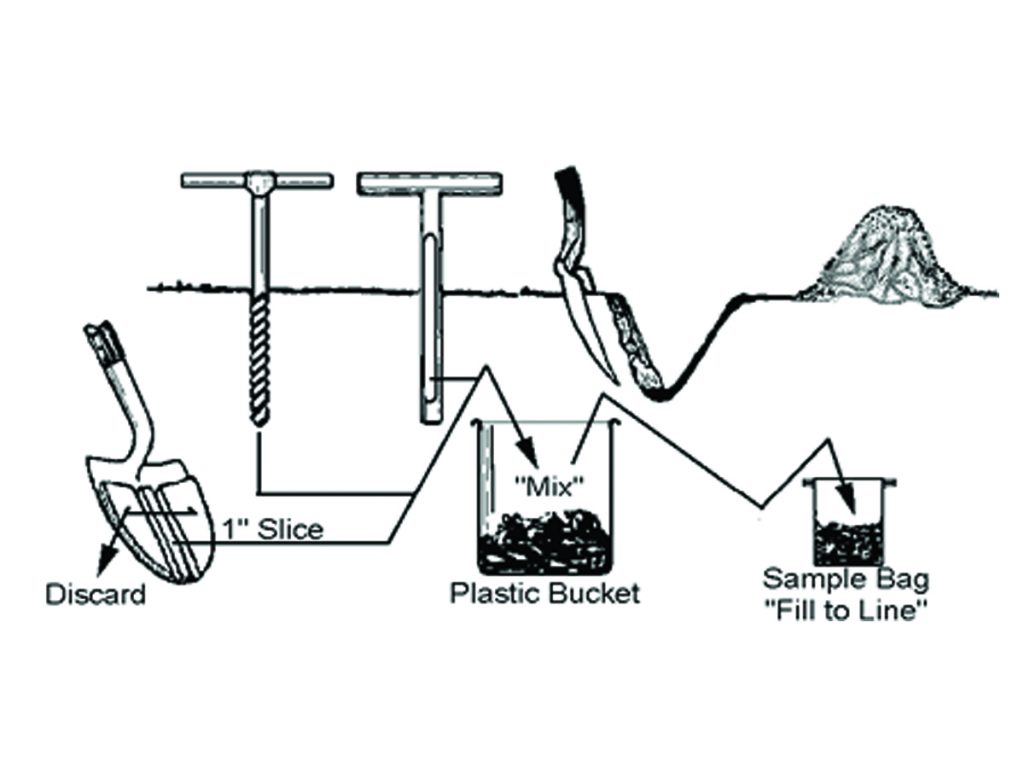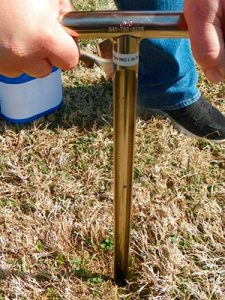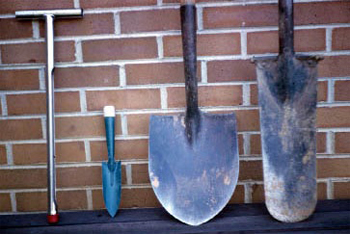Did you survive the winter snow and cold? Are you getting that “Spring Fever”? What about your pasture? Now is the time to start assessing the overall conditions to decide what management steps must be taken to have a productive pasture for the coming year. Looking at the overall pasture composition becomes an important step to determining if any improvement is necessary.
What is the percent of bare ground exposed? Is it due to heavy traffic, over grazing, poor drainage or poor fertility? What is the amount of grass to legumes throughout the pasture? Do you have a lot of weeds?

Demonstration how the soil probe works for gathering soil samples.

Putting probe into soil.
Once we have assessed the actual pasture, do we know what the pH and the fertility is of the pasture? Soil pH should be above 6.0, with a goal of 6.5. Soil phosphorus (P) level should be at 25 ppm (50 lbs./acre) and across much of Ohio, and given an average cation exchange capacity (C.E.C.) soil potassium (K) level should be 100 to 120 ppm (200 to 240 lbs./acre). If your soil is not close to these numbers it may be worthwhile to put off a spring seeding, apply the needed lime and fertilizer this spring and aim for an August seeding.
Another key factor is to know what forages you need for your livestock. All livestock are not the same and grasses and legumes are not the same when looking at quality as well as quantity. Check with your local Extension Educator or seed dealer for recommendations.
Okay, you have answered these questions, now what can you do to renovate your pastures? One low cost option is to do nothing at all. That is if you have enough land base to set aside these areas through spring and early summer. Given enough time, they will renovate themselves. We generally have enough of a seed bank already in the soil. Whether the seed bank contains desirable plants or what percentage of desirable plants will make-up the regrowth are questions to be considered.
Another option is seeding. Do we have time to frost seed, or will we need to over seed or direct seed. Most grasses do not establish well with frost seeding. Legumes that work well in preferred order are: Red Clover, Ladino/white clover, Alsike clover, and Birsdfoot Trefoil. As we get past mid-March, frost seeding is not an option. That leaves us with conventional drilling, use of a no-till drill or broadcast seeding followed by some type of cultipacking.

Tools of the trade for taking soil samples.
Here are some key concepts to follow when seeding forages:
Reduce weed and sod competition for the new seedling. This relates to soil to seed contact. This may require some soil preparation before seeding, this is especially necessary for good broadcast seeding success. Broadcast half the seed rate cross-wise over the pasture and the other half length-wise to get better seed distribution. Follow this with cultipacking to get good seed to soil contact.
Do not seed too deep! Many stand failures come from planting the seed too deep.
Pay attention to seeding rates. Check the label for correct seeding rates suggested and for live seed percentages. If the seeding rate calls for 7 pounds of orchard grass and the live seed is only 70% then we need to seed 8.25 pounds to get the correct rate. Always calibrate the Seeder!
If the specific legume species you are planting has not been in the pasture for a few years make sure you get inoculated seed with the correct rhizobial bacteria to insure plants will be effective in fixing nitrogen. Depending on the source of the seed may or may not be treated. This seed treatment coating can also affect seeding rate. Read the seed label and calibrate the seeder!
No matter what, it will generally take about 6 to 8 weeks for a new seedling to become established. This is the reason behind setting the spring seeding date target around April 20th or before. After the seeding has emerged and begun to grow and once the grass plants get about 6 inches tall, it is beneficial to the stand to either do a clipping or a light grazing pass that takes off the top couple of inches. This will allow light to get down to the young clover seedlings so they get better growth and the clipping/grazing will also stimulate tiller formation in the grass seedlings. Do not graze or clip off the young clover seedlings. After about 8 weeks of growth, or towards the end of June, begin to manage the stand using good rotational grazing principles.
If proper renovations just don’t work out at this time and forages are needed, a short term crop can be planted that will provide some summer grazing. Such crops as annual ryegrass, oats, or even turnips and a cereal grain such as winterheat can provide in about six weeks a good quality forage to graze.
There are options available that allow pasture renovations to be made that can make productive grazing pastures again. The specific option chosen depends upon the resource base of the producer, farm forage goals, and timing. Regardless of the option used, planning, management and some cooperation from Mother Nature are necessary to achieve success.
Article by Tony Nye. He is the state coordinator for the Ohio State University Extension Small Farm Program and has been an OSU Extension Educator for agriculture and natural resources for 29 years, currently serving Clinton County and the Miami Valley EERA. Tony and his family also own and operate a small livestock farm in Washington Court House, Ohio, raising purebred swine and meat goats.


